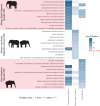Elephant Genomes Reveal Accelerated Evolution in Mechanisms Underlying Disease Defenses
- PMID: 33944920
- PMCID: PMC8383897
- DOI: 10.1093/molbev/msab127
Elephant Genomes Reveal Accelerated Evolution in Mechanisms Underlying Disease Defenses
Abstract
Disease susceptibility and resistance are important factors for the conservation of endangered species, including elephants. We analyzed pathology data from 26 zoos and report that Asian elephants have increased neoplasia and malignancy prevalence compared with African bush elephants. This is consistent with observed higher susceptibility to tuberculosis and elephant endotheliotropic herpesvirus (EEHV) in Asian elephants. To investigate genetic mechanisms underlying disease resistance, including differential responses between species, among other elephant traits, we sequenced multiple elephant genomes. We report a draft assembly for an Asian elephant, and defined 862 and 1,017 conserved potential regulatory elements in Asian and African bush elephants, respectively. In the genomes of both elephant species, conserved elements were significantly enriched with genes differentially expressed between the species. In Asian elephants, these putative regulatory regions were involved in immunity pathways including tumor-necrosis factor, which plays an important role in EEHV response. Genomic sequences of African bush, forest, and Asian elephant genomes revealed extensive sequence conservation at TP53 retrogene loci across three species, which may be related to TP53 functionality in elephant cancer resistance. Positive selection scans revealed outlier genes related to additional elephant traits. Our study suggests that gene regulation plays an important role in the differential inflammatory response of Asian and African elephants, leading to increased infectious disease and cancer susceptibility in Asian elephants. These genomic discoveries can inform future functional and translational studies aimed at identifying effective treatment approaches for ill elephants, which may improve conservation.
Keywords: EEHV, tuberculosis, genomes; cancer; conservation; disease; elephants.
© The Author(s) 2021. Published by Oxford University Press on behalf of the Society for Molecular Biology and Evolution.
Figures



References
-
- Balkwill F.2009. Tumour necrosis factor and cancer. Nat Rev Cancer. 9(5):361–371. - PubMed
-
- Benton MJ, Donoghue PCJ, Asher RJ, Friedman M, Near TJ, Vinther J.. 2015. Constraints on the timescale of animal evolutionary history. Palaeontol. Electron. 18:1–106.
Publication types
MeSH terms
Grants and funding
LinkOut - more resources
Full Text Sources
Other Literature Sources
Research Materials
Miscellaneous

